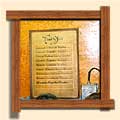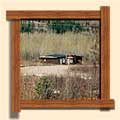|

[Cliquez ici pour le texte en français]
 The impact of the miners was
balanced by the pervasive presence of the companies in the
towns. After establishing the communities, the mining firms
continued to exert substantial influence, not only at the mine
sites but also frequently in the towns proper, by controlling
housing, stores, and public works. The situation tended to
deepen the conflict between capital and labour. Company stores
tended to charge high prices. During strikes, the owners
sometimes used housing and stores as weapons, evicting miners
and refusing them credit to buy supplies.1 The impact of the miners was
balanced by the pervasive presence of the companies in the
towns. After establishing the communities, the mining firms
continued to exert substantial influence, not only at the mine
sites but also frequently in the towns proper, by controlling
housing, stores, and public works. The situation tended to
deepen the conflict between capital and labour. Company stores
tended to charge high prices. During strikes, the owners
sometimes used housing and stores as weapons, evicting miners
and refusing them credit to buy supplies.1
 The extent of company influence
varied in different parts of the region. It was most complete in
towns where owners controlled all the property. Beginning in the
1880s, conservation and tourism concerns led governments to
set aside virtually all of the
Alberta Rockies to the north of
the main line of the CPR at Banff for parks and forestry
reserves. This land remained crown property. Paradoxically,
industrial activity was still permitted. Governments allowed
coal mine owners to obtain long-term leases, which permitted
them to set themselves up as the sole `proprietors' of the area.
Individuals could not own property, nor could communities
incorporate themselves. The companies in the secluded camps of
the
Coal
Branch,
Nordegg,
Bankhead, and Brule controlled all the
housing, stores, hotels, and theatres.2 The extent of company influence
varied in different parts of the region. It was most complete in
towns where owners controlled all the property. Beginning in the
1880s, conservation and tourism concerns led governments to
set aside virtually all of the
Alberta Rockies to the north of
the main line of the CPR at Banff for parks and forestry
reserves. This land remained crown property. Paradoxically,
industrial activity was still permitted. Governments allowed
coal mine owners to obtain long-term leases, which permitted
them to set themselves up as the sole `proprietors' of the area.
Individuals could not own property, nor could communities
incorporate themselves. The companies in the secluded camps of
the
Coal
Branch,
Nordegg,
Bankhead, and Brule controlled all the
housing, stores, hotels, and theatres.2
 In other coalfields,
entrepreneurial control was considerably less extensive. In the
Drumheller Valley, for instance, many owners did not have enough
sufficient capital to invest in housing or company stores. In
the Crowsnest Pass, company influence tended to lessen over
time. At first, a series of towns emerged in which the companies
owned all the property-at
Michel, Coal Creek, and other places.
The owners, however, soon realized that this situation tended to
worsen relations with workers, and greater stability tended to
result when miners were allowed to own their own property.
Shortly after 1900, the Crows Nest Pass Coal Company, and other
firms, began offering lots for sale. By the First World War,
most entrepreneurs had divested themselves of company stores,
which had proven a great provocation both to miners and
independent businessmen, and were in the process of selling
their residential holdings.3 In other coalfields,
entrepreneurial control was considerably less extensive. In the
Drumheller Valley, for instance, many owners did not have enough
sufficient capital to invest in housing or company stores. In
the Crowsnest Pass, company influence tended to lessen over
time. At first, a series of towns emerged in which the companies
owned all the property-at
Michel, Coal Creek, and other places.
The owners, however, soon realized that this situation tended to
worsen relations with workers, and greater stability tended to
result when miners were allowed to own their own property.
Shortly after 1900, the Crows Nest Pass Coal Company, and other
firms, began offering lots for sale. By the First World War,
most entrepreneurs had divested themselves of company stores,
which had proven a great provocation both to miners and
independent businessmen, and were in the process of selling
their residential holdings.3
 Regardless of the housing
situation, the company continued to be physically represented in
most towns by its managers. Managers usually lived apart from
the miners in better housing provided by the companies, often in
more attractive locations. At
Hillcrest and
Frank in the Pass,
for instance, the houses of the officials were perched on hills
overlooking the rows of miners' cottages. At Nordegg, managers
and workers literally lived on different sides of the tracks.4 Regardless of the housing
situation, the company continued to be physically represented in
most towns by its managers. Managers usually lived apart from
the miners in better housing provided by the companies, often in
more attractive locations. At
Hillcrest and
Frank in the Pass,
for instance, the houses of the officials were perched on hills
overlooking the rows of miners' cottages. At Nordegg, managers
and workers literally lived on different sides of the tracks.4
William N.T. Wylie, "Coal-Mining
Landscapes: Commemorating Coal Mining in Alberta and
Southeastern British Columbia," a report prepared for the
Historic Sites and Monuments Board of Canada, Parks Canada
Agency, 2001.
See Also: The Coal
Industry—Overview, Rapid Expansion,
Domestic and Steam Coalfields,
1914-1947: The Struggling Industry,
Collapse and Rebirth,
Settlement of the West,
Issues and Challenges—Overview,
Entrepreneurship, Technology,
Underground Techniques,
Surface Technology,
Surface Mining,
Social Impacts,
Unions,
1882-1913: Unionization and Early Gains,
1914-1920: Revolutionary Movement,
1921-1950s: Labour Unrest and
Setbacks, Mining Companies, People of
the Coal Mines,
The Middle Class,
Miners and Local
Government,
Politics and Economics ,
Environmental Impacts,
Health and Safety—Overview
The State and
Labour Relations,
The State and
Development after 1918.
|
 Heritage Community Foundation Presents
Heritage Community Foundation Presents








